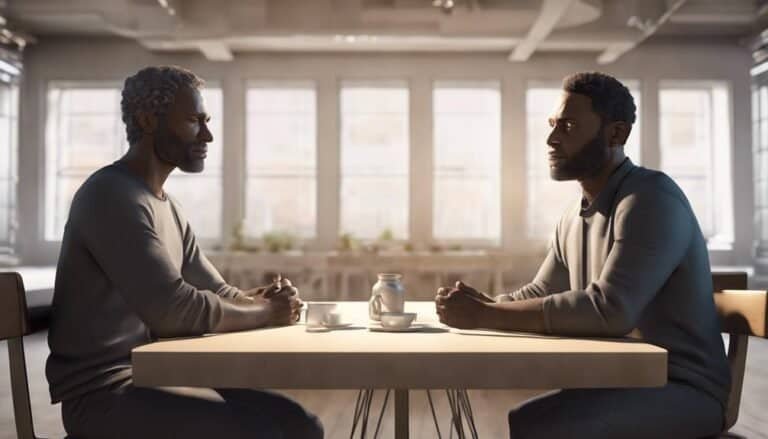Conflict Management in Sports Teams
“The strength of the team is each individual member. The strength of each member is the team.” – Phil Jackson
In sports, conflict is a normal part of the game, whether at the top level or among friends. Different backgrounds and personalities can lead to disagreements. That’s why learning how to solve conflicts in sports teams is key for coaches and team leaders.
Coaches are crucial in this area. They use important talks and strategies to make sure everyone can speak freely and listen well. This approach helps solve conflicts and boosts communication, making the team work better together.
Key Takeaways
- Conflict management is vital due to team diversity.
- Open dialogue fosters transparency and unity.
- Active listening builds mutual respect.
- Clear norms reduce potential conflicts.
- Mediation techniques can resolve team conflicts.
- Common goals can refocus team energy.
- Personal development aids better conflict resolution.
Understanding Conflict in Sports Teams
Conflict in sports teams is common and comes from different views and values among team members. It’s key to understand these conflicts to keep the team together.
Definition of Conflict
Conflict in sports teams means when team members disagree on goals, values, or roles. These disagreements can come from personal issues, jealousy, or different goals within the team.
Common Causes of Conflict
Common reasons for conflicts in sports teams are:
- Goals that don’t match
- Confusion over roles
- Poor communication
- Clashing personalities
- Competition for playing time
Knowing these reasons helps in handling conflicts better.
Types of Conflicts in Sports
There are different kinds of conflicts in sports teams, each needing its own way to be solved:
- Interpersonal Conflicts: These are between team members.
- Intrapersonal Conflicts: These are within one person, like feeling stressed or unsure.
- Intergroup Conflicts: These are between different groups in the team.
- Intragroup Conflicts: These happen within a single group in the team.
Knowing these types helps in resolving disagreements in athletic teams by tackling the main issues and using the right ways to solve them.
Recognizing Early Signs of Conflict
It’s key to spot conflicts in sports teams early to keep the team strong and prevent bigger problems later. Conflict is normal in any team, and catching its early signs helps in solving disputes.
Behavioral Indicators
Some behavioral indicators show early conflict in a team. Look out for unfriendly behavior, being left out, missing practice, and a drop in performance. Also, check team texts or emails for any misunderstandings.
Non-Verbal Cues
Non-verbal cues are also important to watch for. Signs like eye-rolling, crossed arms, and avoiding eye contact hint at deeper issues. Coaches and team members should notice these signs to tackle conflicts early.
Impact of Unaddressed Conflict
Ignoring conflicts can make things worse, hurting the team’s work and communication. Having good ways to solve conflicts from the start helps. Regular team meetings can be a place to work out issues, as suggested in “Building Teams Building People” by Thomas Harvey and Bonita Drolet. Handling conflicts well helps teams grow and be more daring.
Negative and Positive Outcomes of Conflict
Conflict in sports teams can have both good and bad effects on how the team works together. It’s key to know these effects for better conflict resolution. By looking at the different impacts, we see why managing conflicts well is so important.
Negative Impacts on Team Dynamics
Conflicts that aren’t solved can make things worse in a team. They can lead to feelings of defeat, more anxiety, stress, and worse team performance. Trust can drop, making communication harder and reducing work output.
Relationships can also get worse, making the team less united. Tim Walton, known for his success with the Florida Gators, says being thoughtful, brief, and consistent in dealing with conflicts helps avoid these problems.
Positive Growth and Cohesion
On the other hand, handling conflicts well can bring many benefits. It can boost motivation, creativity, and new ideas. It helps clear up issues and can make the team perform better.
Teams can become more tolerant, trust each other more, and have stronger bonds after conflicts. Walton’s success, like his 17 years with the Florida Gators and two championships, shows how talking things out can make a team stronger and more united.
In sports, using conflict resolution methods like DISC can stop conflicts from getting worse. DISC stands for Dominance, Influence, Steadiness, and Conscientiousness in behavior. By understanding and using these styles, coaches and team members can turn conflicts into positives. Good conflict resolution is key for team success and harmony.
Effective Strategies for Conflict Resolution
Knowing how to handle team conflict resolution strategies is key for a positive team environment. Conflicts often come from different behaviors, interests, or values. Spotting these early can stop things from getting worse. Good strategies help ease tension and bring teams closer together.
Communication Techniques
Good communication is the heart of solving conflicts. Using active listening, avoiding making assumptions, and talking constructively are key. Open and honest talk builds trust and clears up any confusion among team members.
Role of Empathy and Understanding
Empathy is very important in team conflict resolution strategies. By seeing things from another team member’s point of view, we can better understand their feelings and thoughts. This helps in solving problems together and builds respect, making the team more united.
Steps to Resolving Conflicts
A step-by-step plan helps in solving conflicts. Here are some steps to follow:
- Share Facts: Begin by sharing the facts to clear up any confusion and make sure everyone knows the situation.
- Tell Your Story: Then, share how the conflict affects you personally.
- Ask for Others’ Perspectives: Ask your teammates to share their views, making sure everyone’s heard.
- Talk Tentatively: Talk with an open mind and a gentle approach to keep the conversation calm.
- Encourage Testing: Let everyone question and test the ideas, making sure everyone understands and agrees.
Following these steps with team conflict resolution strategies can lead to lasting solutions. It reduces the chance of future conflicts and helps the team work better together.
Critical Conversations in Conflict Management
Effective sports team conflict resolution relies on deep talks that tackle the real issues. These talks are key to solving disputes and building a united team. They also help everyone respect each other more.
Steps to Conducting Critical Conversations
Starting these talks needs a plan. First, set a clear agenda and make sure everyone wants to talk. Keeping the mood calm helps everyone open up. Make sure each person gets a turn to speak, keeping the talk respectful and focused on finding solutions.
Importance of Facts and Stories
Sharing facts is the base for good talks. It’s important to know the difference between conflict and bullying. Conflict is when both sides share their views, but bullying means one side has more power. After facts, stories help share personal views, making the talk more relatable and less harsh.
Encouraging Open Dialogue
Talking openly is key in sports team conflict resolution. It lets team members share their worries and what they hope for. Writing things down can help athletes think and talk better about their feelings. It’s also important to stop and calm down when feelings get too strong, then keep talking in a good way.
- Set clear objectives
- Maintain a respectful atmosphere
- Ensure equal participation
- Fact-sharing and storytelling
- Allow journaling and reflection
- Pause when necessary to manage emotions
By following these steps, teams can turn conflicts into chances to grow. This makes the team work better and boosts morale. Managing conflict is not just about solving problems. It’s about making a stronger, more united team.
The Role of Coaches in Conflict Management
Coaches are key in solving team conflicts and preventing them from getting worse. They use proactive conflict policies and build a positive team culture. This helps improve team dynamics and performance.
Proactive Conflict Policies
It’s important to have clear conflict policies for teams. Coaches should work with athletes to create these policies. This makes sure everyone knows what’s expected of them.
Setting rules for bad behavior helps show how important discipline is. It’s linked to team success.
Building a Positive Team Culture
A positive team culture is key to avoiding and solving conflicts. Coaches should lead by example, setting high standards and encouraging open talk. This builds strong team values and goals for success.
Facilitation Techniques
Coaches need good facilitation skills to handle team conflicts. They guide athletes in solving conflicts and teach them to speak up. This stops conflicts from getting worse and helps create a respectful team.
By giving athletes a chance to talk about their issues, coaches can make solving conflicts easier and more effective.
Using these methods, coaches can reduce conflicts and turn them into chances for team growth and unity.
Conflict Management Techniques for Sports Officials
Sports officials are key to keeping games fair and running smoothly. They need to be professional, calm, and strategic when dealing with conflicts. Here are some important strategies for officials to manage conflicts during games.
Minimizing Conflict During Games
Conflicts can happen for many reasons, like disagreements over penalties or frustration with performance. To solve these issues, officials should step in early, make quick decisions, and stay fair. They need to enforce the rules strongly but fairly to earn respect and stop conflicts from getting worse.
It’s important for officials to act quickly, stay alert, and not take things personally. These actions help prevent conflicts from starting.
Remaining Calm and Professional
Keeping a calm and professional attitude is a top way to solve conflicts in sports. Officials should avoid arguing and focus on the issue at hand, not people’s feelings. Using names, being clear, and being open helps calm things down. Staying fair and confident keeps officials in control without showing favoritism.
Addressing the Problem, Not Emotions
In the intense world of sports, dealing with conflicts right away and ignoring emotions is key. Officials should focus on the real issues, give clear instructions, and explain their decisions with facts. Being empathetic, a good listener, and offering choices instead of ultimatums helps solve disputes. This shows that smart conflict handling makes sports better for everyone.
Teaching Assertiveness and Emotional Control
In team sports, it’s key to teach athletes how to be assertive and control their emotions. This helps them handle conflicts better and solve problems effectively. Being assertive means they can share their thoughts and feelings in a respectful way. Emotional control helps them stay calm under pressure.
Assertiveness vs. Aggressiveness
It’s important to know the difference between being assertive and aggressive. Being assertive means speaking up for oneself in a respectful way. It helps create a positive team environment. Aggressive behavior, however, can make conflicts worse and harm the team. Coaches should teach athletes to communicate assertively without being aggressive.
- Assertiveness involves clear and direct communication while maintaining respect.
- Aggressiveness often involves hostility and can provoke further conflict.
Techniques for Emotional Regulation
Managing emotions is key in sports. Athletes can use techniques like deep breathing, mindfulness, and visualization to stay calm. These methods help with personal growth and improve team dynamics.
- Deep Breathing: Helps reduce stress and increase concentration.
- Mindfulness: Encourages athletes to stay present and minimize anxiety.
- Visualization: Prepares athletes mentally for challenging scenarios.
Grounding Exercises for Athletes
Grounding exercises help athletes stay in control of their emotions during stressful times. They prevent conflicts by keeping athletes focused on their goals. Here are some examples:
- 5-4-3-2-1 Technique: Identifying five things you can see, four things you can touch, three things you can hear, two things you can smell, and one thing you can taste.
- Progressive Muscle Relaxation: Tensing and then relaxing different muscle groups to reduce tension.
- Sensory Awareness: Focusing on sensory stimuli (e.g., feeling the texture of the ball) to bring oneself to the present moment.
By using these practices, sports teams can handle conflicts better. This leads to better performance and happier teams.
Conclusion
In sports, handling conflicts within teams is key. Dealing with issues early helps improve relationships and performance. It also helps athletes grow personally.
Coaches and athletic leaders are crucial in this process. People like Jo Ito and Jeff Lowell show how to manage conflicts well. They have years of experience in leading teams.
They use methods like proactive communication and the True Colors tool to solve problems. Training coaches in mediation and self-advocacy is also important. The goal is to prevent conflicts with clear communication and strong leadership.
Source Links
- What are effective conflict resolution techniques for diverse sports teams?
- The Coach’s Guide to Managing Conflict in Sport | Athlete Assessments
- 8 Ways Athletes Can Resolve Conflicts Without Bullying
- How to Solve Conflict Between Your Players
- Resolving Conflict within a Youth Sport Team – The Sport Information Resource Centre
- The 5 types of conflicts in athletic programs | Coach & Athletic Director
- Managing Conflict in Sport using DISC | Athlete Assessments
- 10 Rules to Manage Conflict Like a Pro | Versus
- Coaching Through Conflict: Effective Communication Strategies
- And Breathe: How To Prevent, Manage and Master Difficult Conversations
- Conflict Management – Sports Conflict Institute
- Conflict within Teams | Coach Brock Bourgase
- How to best manage conflict in your sports team | InnerDrive
- Mastering Conflict Resolution in Sports Coaching: A Comprehensive Guide for Soccer Coaches
- Suggested Steps Toward Managing Conflict in Sports – Sports Conflict Institute
- Conflict management skills essential for effective officiating
- 5 Ways to Manage Conflict – Referee.com
- A Coach’s Guide to Communicating with Athletes and Players, Groups and Teams – Personal Trainer Certification, Nutrition Courses, Fitness Education
- Resolving Conflicts within Sports Teams: A Psychological Approach
- Teamwork Conflict Management Training and Conflict Resolution Practice via Large Language Models
- Are We Who We Say We Are?







